Ohio is a great place for birders. It offers natural beauty, state parks, lakes, rivers, cities, towns, and rolling fields. With significant seasonal changes between summer and winter, Ohio is also great for traveling birds.
Our Wild Bird Scoop guide to Birds in Ohio offers an overview of just some of the incredible birds you can find here. The Ohio Department of Natural Resources states that there are 427 species of birds that have been documented here!
Of those 427 birds, there are about 20 kinds of sparrows that live in or routinely visit Ohio. This list is designed to help bird watchers identify these sparrows!
But first, let’s talk about what sparrows are in the first place.
What Makes a Sparrow a Sparrow?
The Spruce explains that “sparrow” is a term applied to “a wide range of relatively small, mostly drab brown birds, which birders often call “LBJs” or “little brown jobs” because they can be notoriously difficult to identify. While many of these birds include the word “sparrow” in their common names, other types of sparrows include buntings, towhees, and juncos.”
Here’s what they tend to have in common:
- They are all Passerines (songbirds)
- They are small, usually between 4-8 inches in length
- Their plumage is mostly tan, brown, and buff – which makes them great at camouflaging themselves!
- They have a short, stocky, cone-shaped bill
How Many Kinds of Sparrows Are in Ohio?
Aside from the very rare accidental vagrants that may get documented in the state once in a lifetime, there are 20 kinds of sparrows in Ohio.
These 20 species are explored in this list.
To learn to differentiate sparrows from one another, look for details like this:
- How big is the sparrow? (Length, weight, wingspan)
- What is its coloring – head, wings, chest, tail, neck, etc
- Where it was spotted – what part of Ohio and what kind of habitat
- What sounds it was making (songs, calls, buzzing, etc)
- What it was eating
- Any interesting behaviors
It’s true that identifying sparrows is a challenge, but it’s not impossible! With some practice, you can definitely learn to distinguish these different varieties from each other.
To make it easier to use this list, we’re dividing the sparrows into common birds that you may find in Ohio year-round, those that are here only in the summer or winter, and those that stop by as they migrate between their summer and winter ranges.
Let’s get started!
Sparrows in Ohio Year-Round
A small number of species of sparrows make their home in Ohio year-round. Some are non-migratory species that stay put all year, whereas others are short-distance or partial migrants who only travel a short distance every year. The sparrows you’ll find throughout the year in Ohio are the Field Sparrow, the House Sparrow, the Song Sparrow, and the Swamp Sparrow.
Field Sparrow
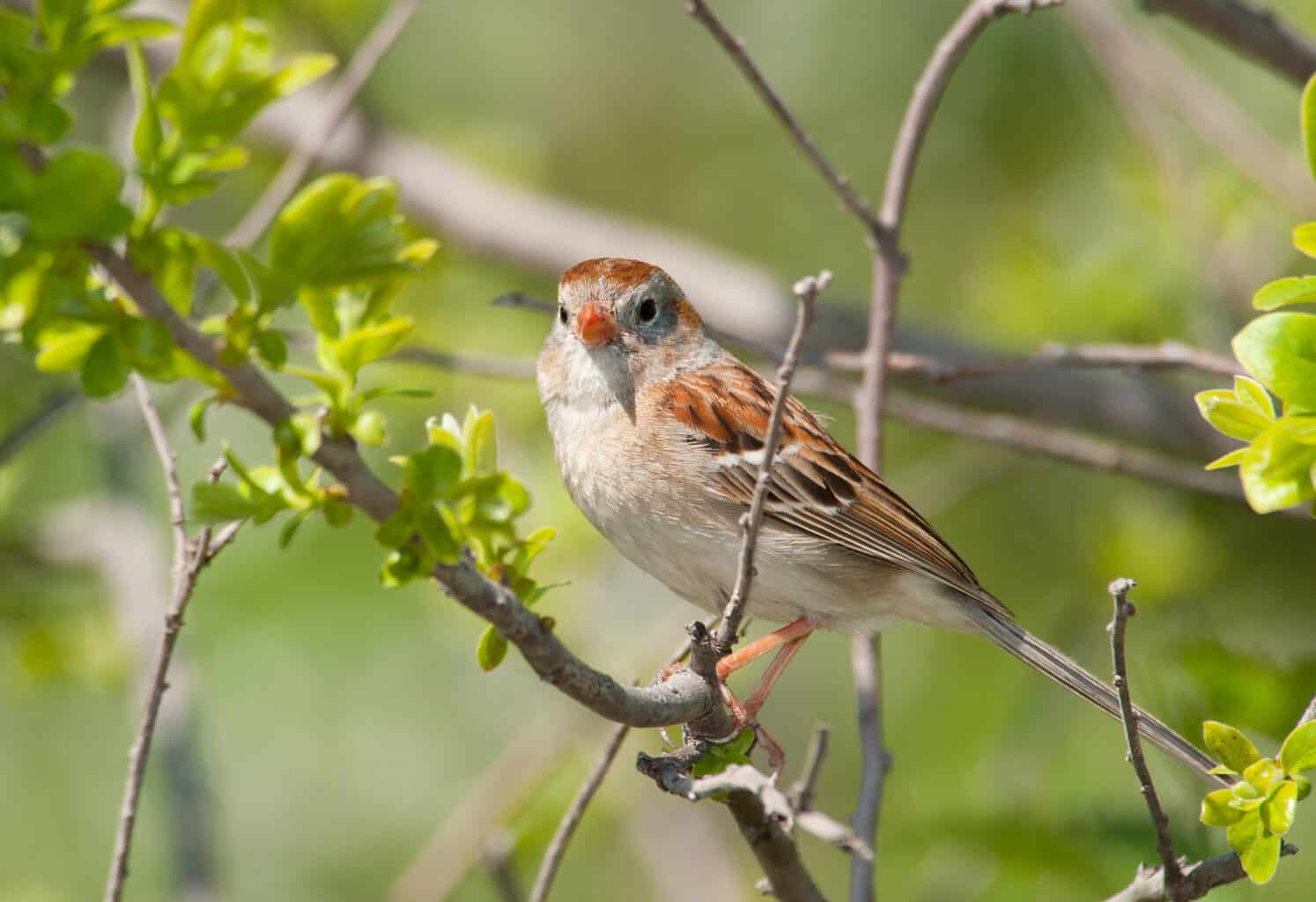
- Spizella pusilla
- ORDER: Passeriformes
- FAMILY: Passerellidae
- Length: 4.7-5.9 in (12-15 cm)
- Weight: 0.4-0.5 oz (11-15 g)
- Wingspan: 7.9 in (20 cm)
The Field Sparrow is lightly colored with gray and dark brown streaks on the back and wings. Their cap is reddish-brown, and they have a pink bill and white eyerings.
Field Sparrows, as opposed to House Sparrows who are next on our list, avoid people. They prefer to stick to wide-open spaces like fields and prairies.
Their need for this kind of habitat makes suburban expansion a problem for Field Sparrows; they have been declining in population for more than 50 years. Even so, their numbers are still plentiful, and Field Sparrows are a species of Least Concern to conservationists.
Field Sparrows live throughout Ohio, year-round. They are partial migrants, which means that some Field Sparrows will stay pretty close to one area for their lifetimes, and others will migrate. When you see a Field Sparrow in Ohio, you likely won’t know if it’s the same sparrow that has been here all year, or if it’s one that has moved into the area from a more northern breeding range.
House Sparrow
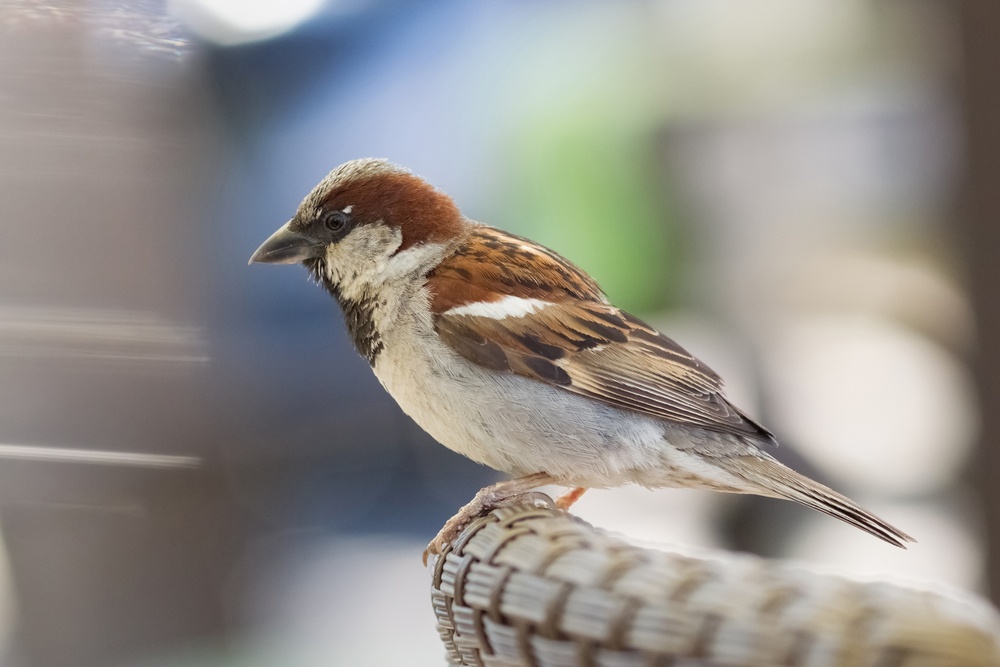
- Passer domesticus
- ORDER: Passeriformes
- FAMILY: Passeridae
- Length: 5.9-6.7 in (15-17 cm)
- Weight: 0.9-1.1 oz (27-30 g)
- Wingspan: 7.5-9.8 in (19-25 cm)
The House Sparrow is probably one of the first sparrows that most people can think of. These little sparrows are known for living in close contact with humans. In fact, they live almost exclusively in human-built structures like barns, overhangs, houses, and utility poles.
Male House Sparrows are mostly brown, with a black bib, a rufous-brown neck, a gray head, and white cheeks. Females are brown with black striping on their backs.
They are very territorial birds who will fight off other birds – even killing them in some cases! They are an invasive species that outcompetes native songbirds for territory and food.
They are widespread throughout Ohio. In urban and suburban areas, you’ll see them all over the place. In more rural areas, look for them nesting and living near houses and businesses.
Song Sparrow

- Melospiza melodia
- ORDER: Passeriformes
- FAMILY: Passerellidae
- Length: 4.7-6.7 in (12-17 cm)
- Weight: 0.4-1.9 oz (12-53 g)
- Wingspan: 7.1-9.4 in (18-24 cm)
Song Sparrows have a lot of regional variation, which means you may need to re-learn how to spot them if you move from one area to another.
All Song Sparrows are brown with white chest streaking and thick white flanks. Their coloring can be light brown or reddish brown, and the amount of streaking may vary.
They return to the same nesting area every year, sometimes even returning to the exact same nest they built last year. As partial migrants, they may not travel very far from their nest in the first place.
During the summer, their diet consists mostly of insects and bugs. Later, they transition to a seed and plant-based diet, as it is harder to find insects in the cold Ohio winter. They are widespread across Ohio all year and are typically found in fields, gardens, thickets, and at backyard feeders.
Swamp Sparrow
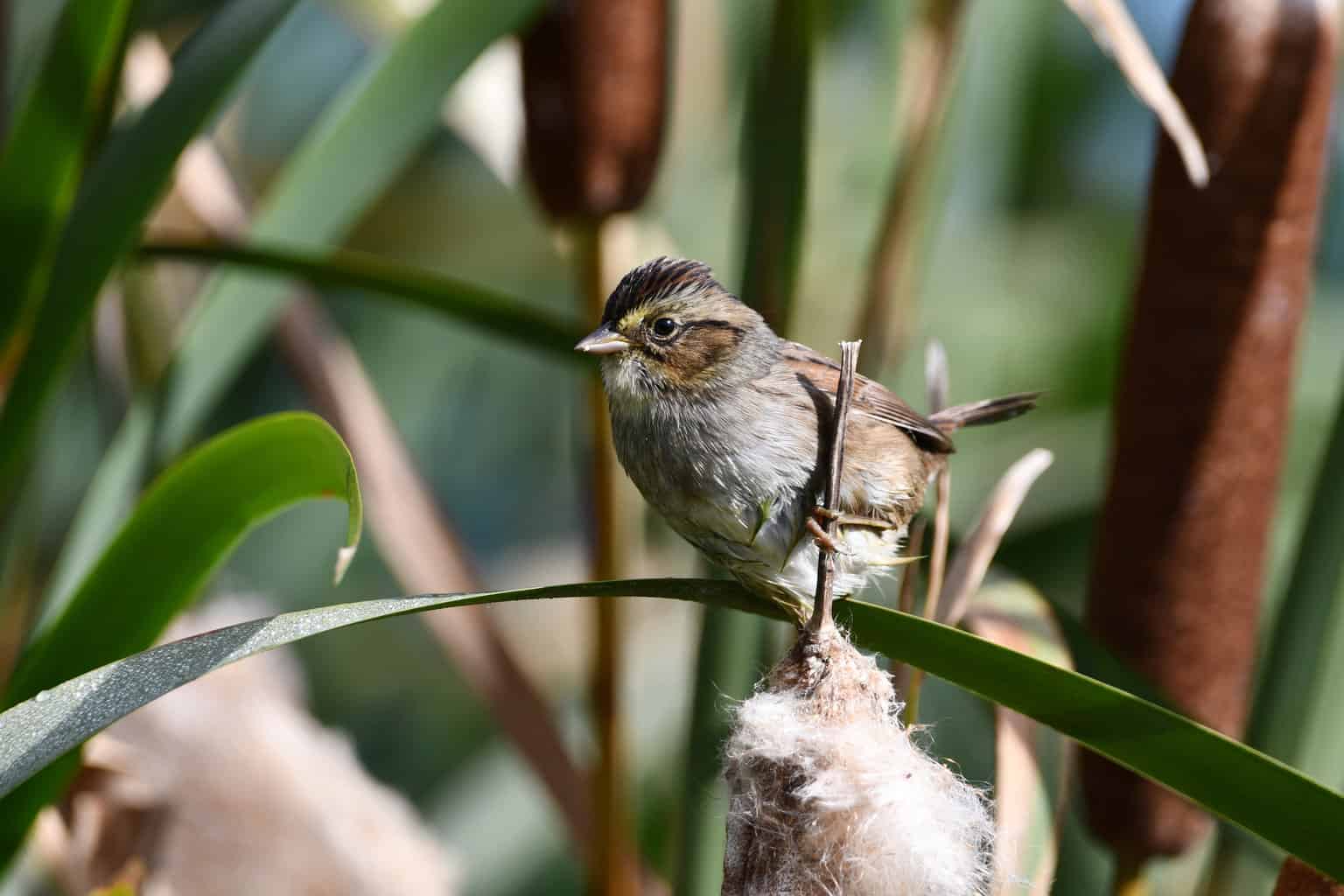
- Melospiza georgiana
- ORDER: Passeriformes
- FAMILY: Passerellidae
- Length: 4.7-5.9 in (12-15 cm)
- Weight: 0.5-0.8 oz (15-23 g)
- Wingspan: 7.1-7.5 in (18-19 cm)
Swamp Sparrows are easy to confuse with Song Sparrows and Chipping Sparrows, but there are some differences.
First, Swamp Sparrows may have round bodies and long tails like the Song Sparrow, but notice how the Swamp Sparrow has reddish-brown wings and a similarly-colored cap on its head.
Next, both Swamp and Chipping Sparrows are red-capped, but Swamp Sparrows are larger and less noisy.
Swamp Sparrows have big, strong legs that they use to forage through thick mud in their preferred wetland habitats. They are found in swamps and cattail marshes in the summer. Then, in winter, they may move to drier areas – or they may stay in the marshes.
That is to say, Ohio has plenty of habitat options for them! They are found all year, throughout the state.
Sparrows in Ohio During the Summer Only
Next, let’s take a look at the sparrows that only visit Ohio during the summer to find a mate, breed, and raise their hatchlings. There are 8 kinds of sparrows that are present in Ohio during the summer, but not for the rest of the year: the Chipping Sparrow, the Eastern Towhee, the Field Sparrow, the Grasshopper Sparrow, the Henslow’s Sparrow, the Lark Sparrow, the Savannah Sparrow, and the Vesper Sparrow.
Combined with the year-round sparrows, these are the birds you will typically find in Ohio between May and August (although some may be here for longer).
Chipping Sparrow
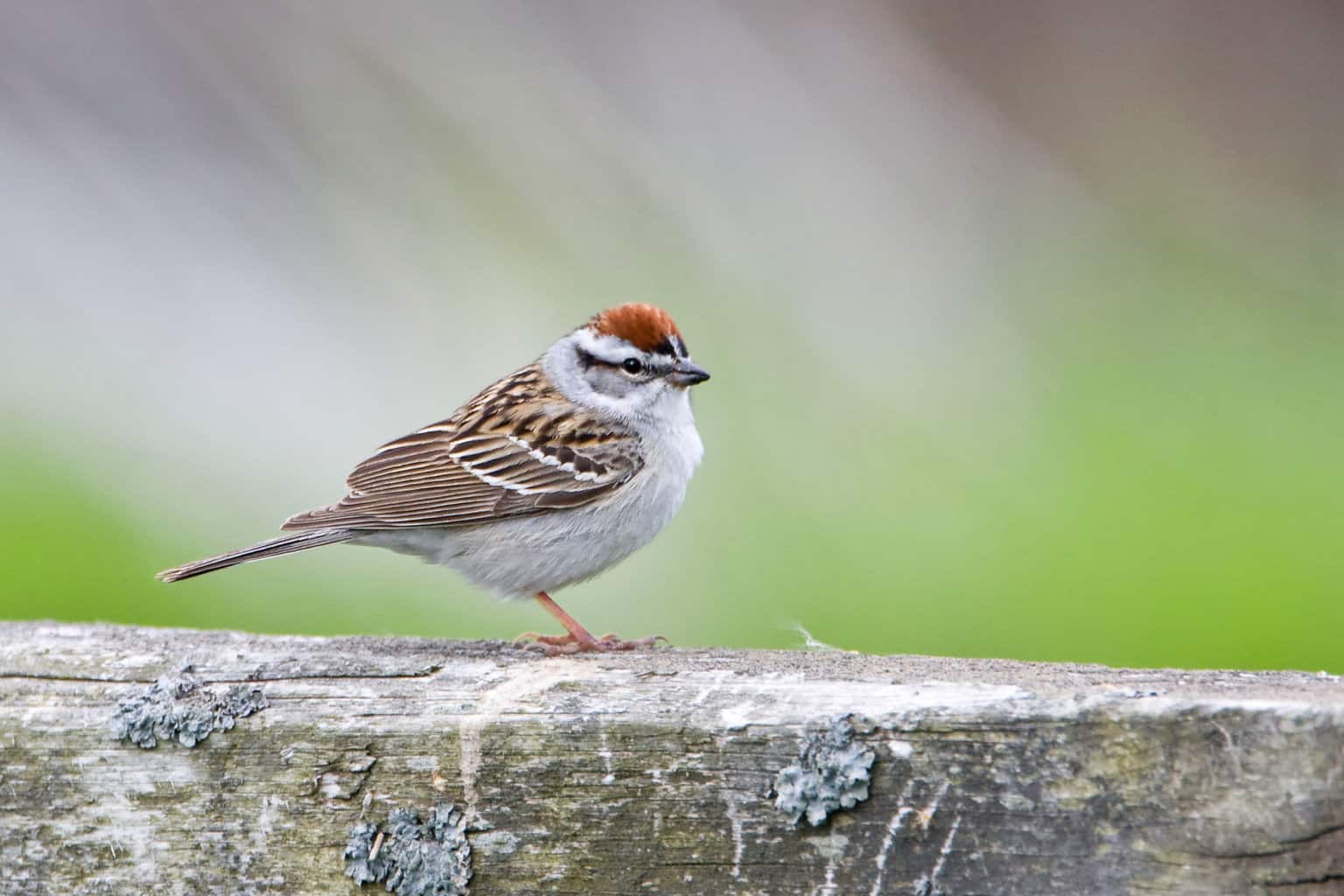
- Spizella passerina
- ORDER: Passeriformes
- FAMILY: Passerellidae
- Length: 4.7-5.9 in (12-15 cm)
- Weight: 0.4-0.6 oz (11-16 g)
- Wingspan: 8.3 in (21 cm)
Chipping Sparrows are very commonplace little birds. They can be identified by their rufous brown cap. Otherwise, the rest of the Chipping Sparrow’s body is streaked in brown and gray.
They have a loud song that trills through the air on warm spring and summer days.
Chipping Sparrows are so plentiful across North America in part because of their simple and accessible habitat preferences. They are found in open woodlands and grassy clearings, as well as feeding at backyard birdfeeders.
All of Ohio will see Chipping Sparrows settle in for the summer. They usually build their nests in conifer trees, although they will sometimes choose a deciduous tree or build a nest on the ground. Many sparrows on this list avoid nesting more than a couple of feet off the ground, but Chipping Sparrows will nest up high if they need to.
The female builds a small, open cup-shaped nest out of clumps of grass, plants, weeds, twigs, and animal hair.
In the fall, they depart for their wintering grounds of coastal Mexico, the Caribbean islands, Florida, and southern California.
Eastern Towhee

- Pipilo erythrophthalmus
- ORDER: Passeriformes
- FAMILY: Passerellidae
- Length: 6.8-8.2 in (17.3-20.8 cm)
- Weight: 1.1-1.8 oz (32-52 g)
- Wingspan: 7.9-11.0 in (20-28 cm)
Meet the cute little Eastern Towhee, who is quite easy to identify. Both males and females look quite different from the other “little brown jobs” on our list, as they are much darker and more dramatically patterned.
The male is dark from above, as his head, back, and neck are all black. He has a white belly and rufous sides.
Females have the same markings, but slightly different colors. Where the male is black, the female is rufous.
Eastern Towhees are sometimes called “Chewinks” thanks to their signature chewink vocalization. They nest on the ground and in common Ohio bushes like honeysuckle, Greenbriar, and grape.
They live year-round in the Ohio River Valley, but they are summer-only residents of the rest of the state. They are usually found in shrubby fields and woodland spaces, as that gives them plenty of ground cover.
Grasshopper Sparrow
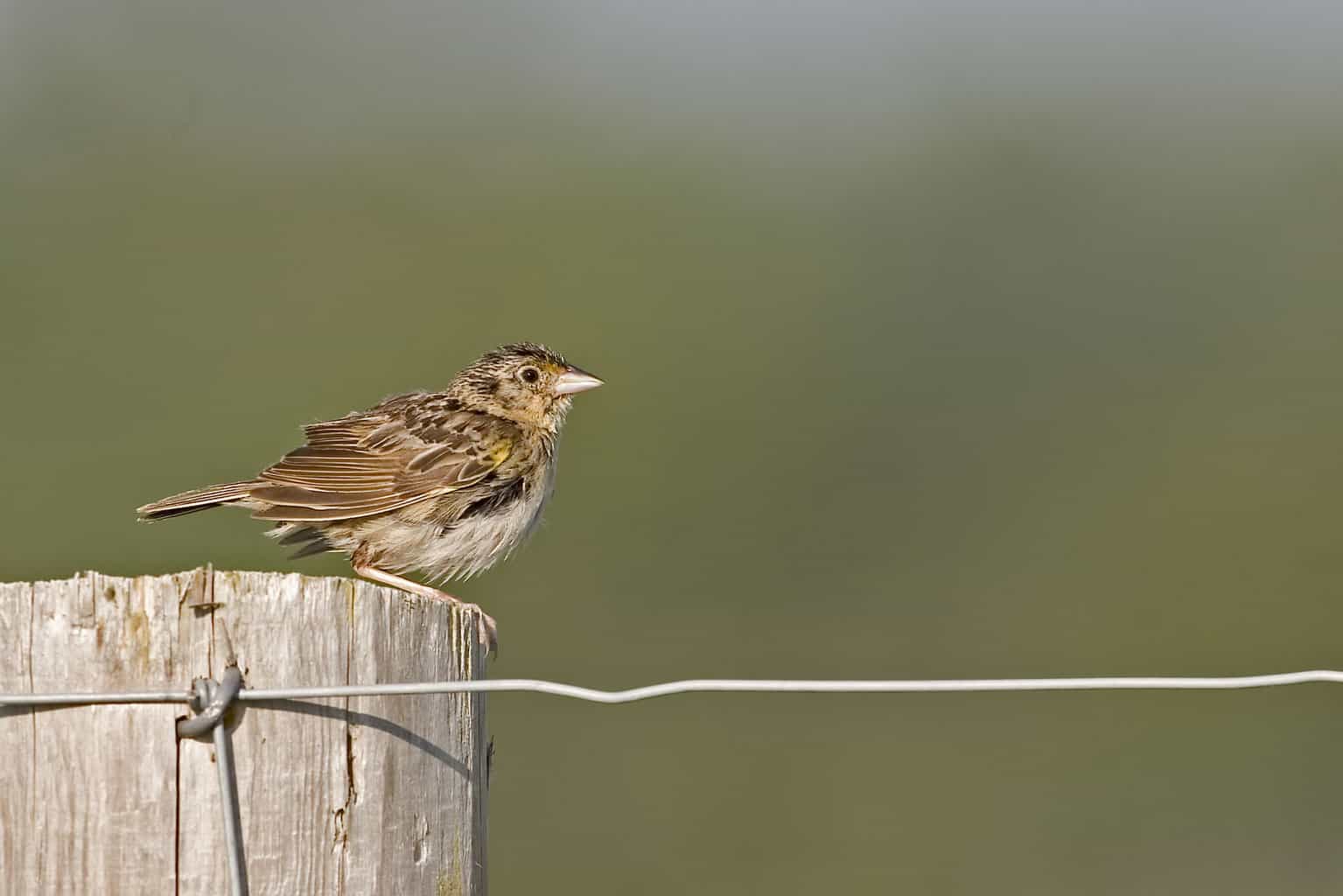
- Ammodramus savannarum
- ORDER: Passeriformes
- FAMILY: Passerellidae
- Length: 4.3-4.5 in (10.8-11.5 cm)
- Weight: 0.5-0.7 oz (14-20 g)
- Wingspan: 7.9 in (20 cm)
Grasshopper Sparrows are stubby-tailed with thick necks. Their coloring varies a bit, ranging from light brown and gray to light orange. Their heads are flat compared to other sparrows, and their bill is large.
Males sing two distinctive songs, which makes them unique among North American sparrows. They have a musical song that they sing while flying, as well as a buzzy, insect-sounding vocalization that gives them their name (they also eat grasshoppers, but that’s not where their name comes from).
Grasshopper Sparrows are plentiful in Ohio during the summer. They are less dependent upon ground cover than other sparrows, preferring grassy fields, prairies, pastures, and hayfields to brushy fields and forests.
Henslow’s Sparrow
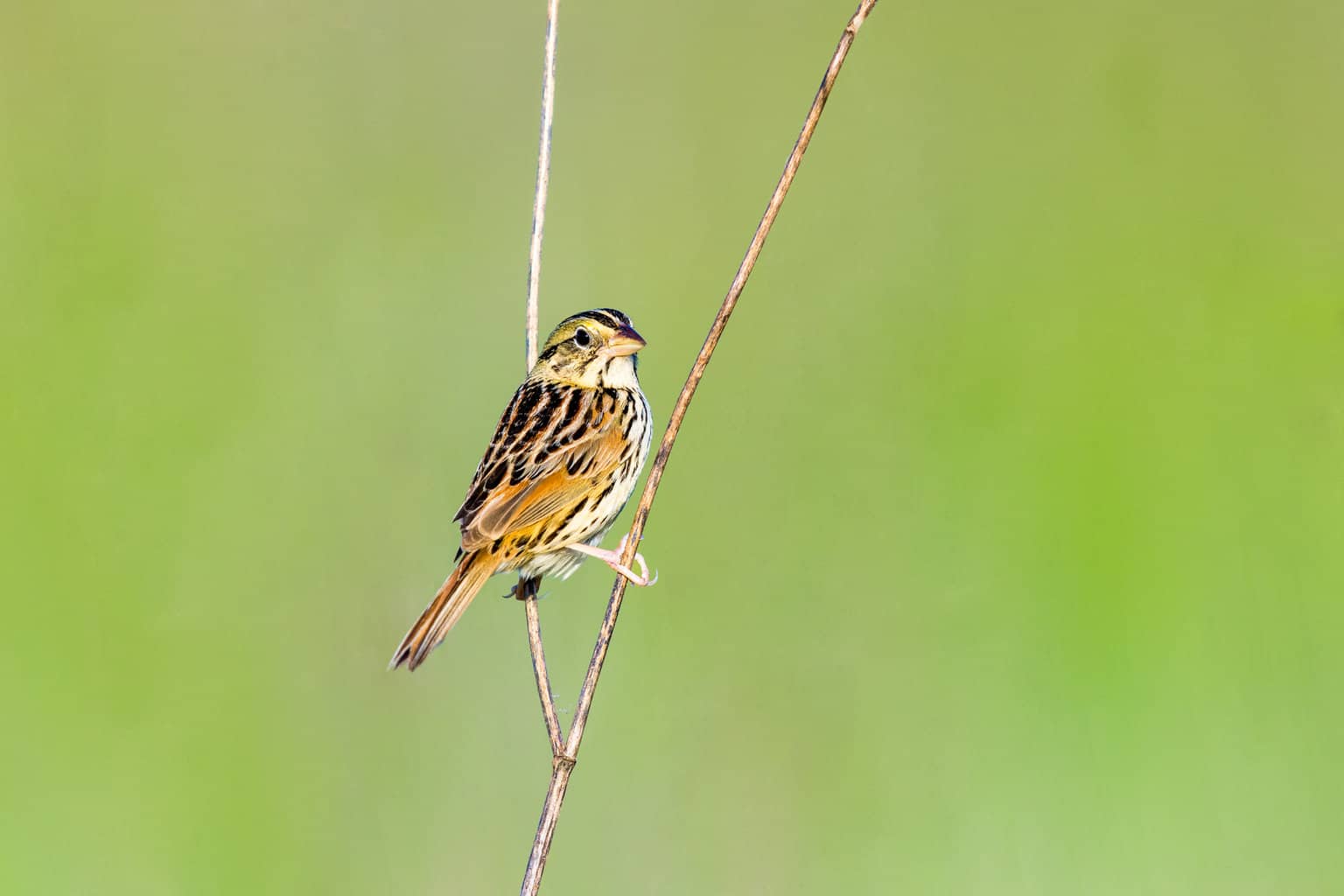
- Centronyx henslowii
- ORDER: Passeriformes
- FAMILY: Passerellidae
- Length: 4.7-5.9 in (12-15 cm)
- Weight: 0.4-0.6 oz (11-16 g)
- Wingspan: 8.3 in (21 cm)
The plain, pretty-looking Henslow’s Sparrow is buff with a bit of pale green or pale yellow coloring. The stripes on their backs and wings are dark.
Henslow’s Sparrows have a diet of bugs and insects during the summer when they are present in Ohio. They eat stink bugs (yay!), caterpillars, crickets, grasshoppers, and beetles. They will even eat wasps, much to the celebration of anyone who has tried to enjoy an Ohio picnic on the 4th of July!
Henslow’s Sparrows have two distinct seasonal ranges. In the summer, they are found exclusively in the Midwest (with some expansion into New York State), and in the winter, they live in the American Southeast.
You’ll find them throughout Ohio.
Lark Sparrow
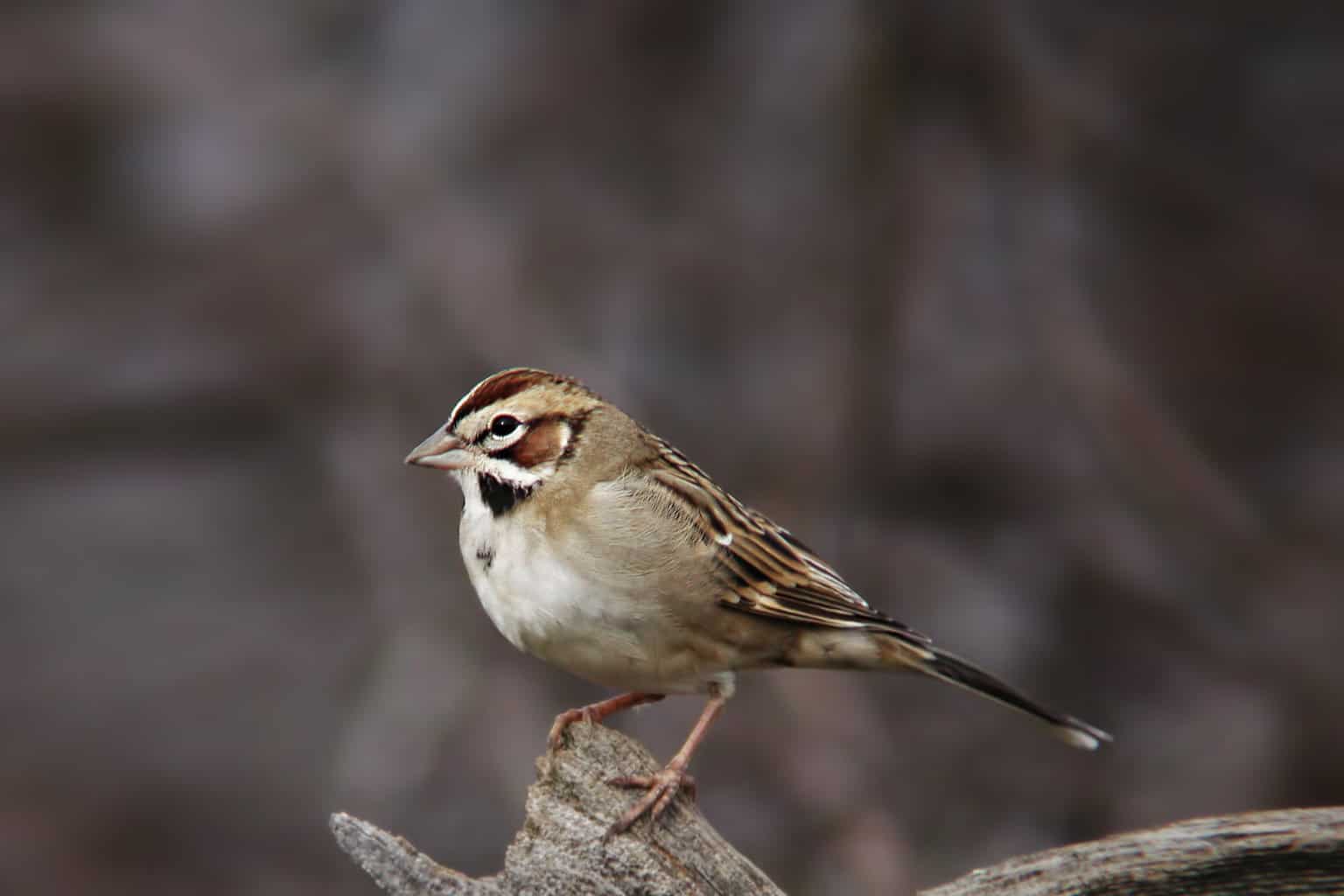
- Chondestes grammacus
- ORDER: Passeriformes
- FAMILY: Passerellidae
- Length: 5.9-6.7 in (15-17 cm)
- Weight: 0.8-1.2 oz (24-33 g)
- Wingspan: 11.0 in (28 cm)
Lark Sparrows are identifiable by the black patch on their chest and the distinctive markings on their face: a dark “mustache” and dark brown stripes.
Lark Sparrows spend most of their time on the ground, although they will fly into trees to avoid predators and other threats.
In addition to building their own nests on the ground or a few feet high in a shrub or tree, Lark Sparrows will also move into the abandoned nests of other birds like Mockingbirds, Kingbirds, Flycatchers, and Thrashers.
Their breeding territory includes the western half of Ohio. They nest in open areas with the occasional bush or tall plant scattered around. They live in shrubby fields, overgrazed pastures, and dry grasslands.
Savannah Sparrow
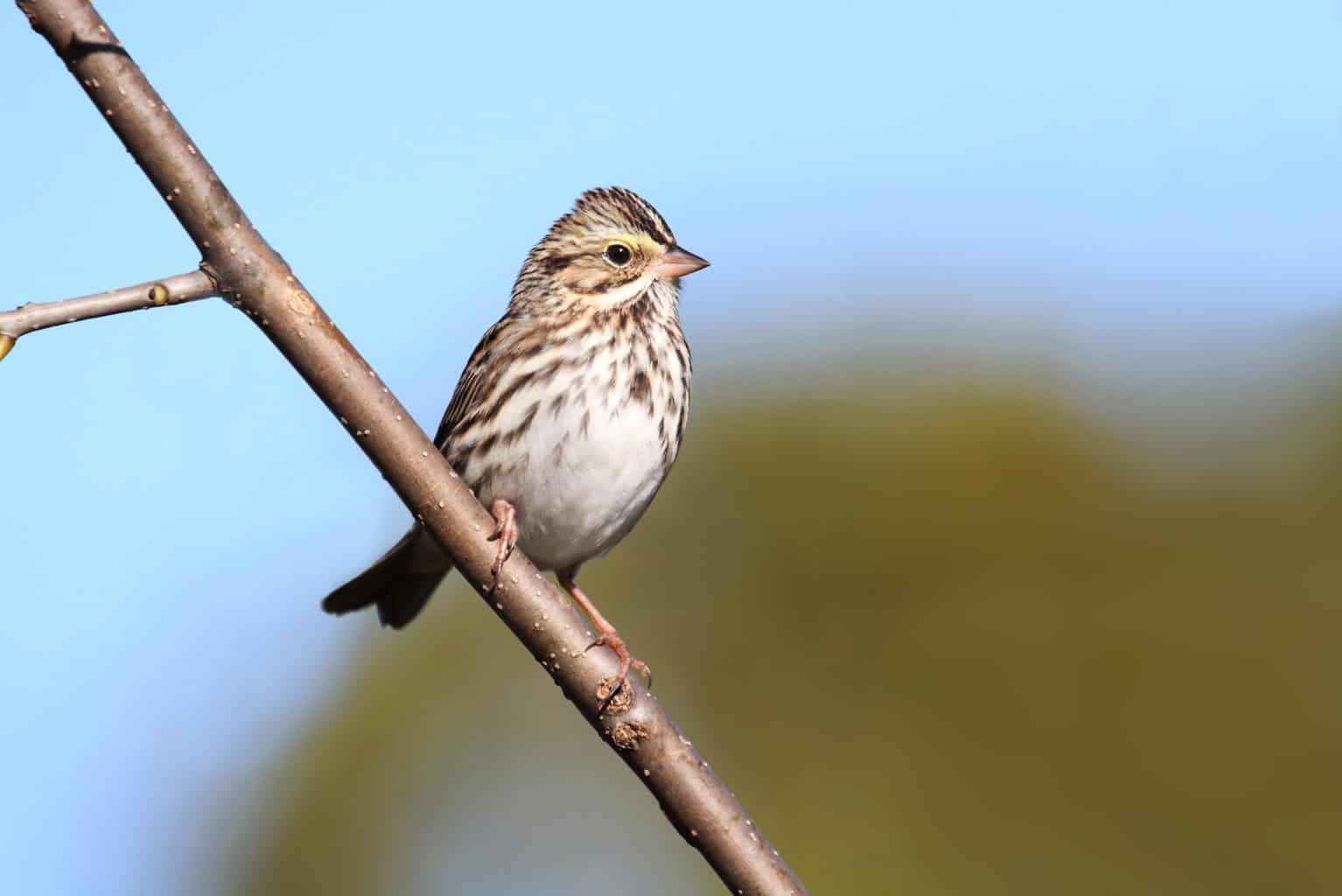
- Passerculus sandwichensis
- ORDER: Passeriformes
- FAMILY: Passerellidae
- Length: 4.3-5.9 in (11-15 cm)
- Weight: 0.5-1.0 oz (15-28 g)
- Wingspan: 7.9-8.7 in (20-22 cm)
To ID a Savannah Sparrow, look for a yellow area between its eyes and its sharp bill. Perhaps an even easier way to recognize this little bird is by sound: they have a very loud, buzzy, insect-sounding call.
With a breeding territory that includes almost all of Canada and the northern half of the US, Savannah Sparrows are incredibly commonplace across most of North America.
In the summer, they are found not just in open meadows, fields, and pastures, but also in the Canadian tundra and along the edges of marshes.
In Ohio, they are found throughout the entire state, all summer long.
Vesper Sparrow
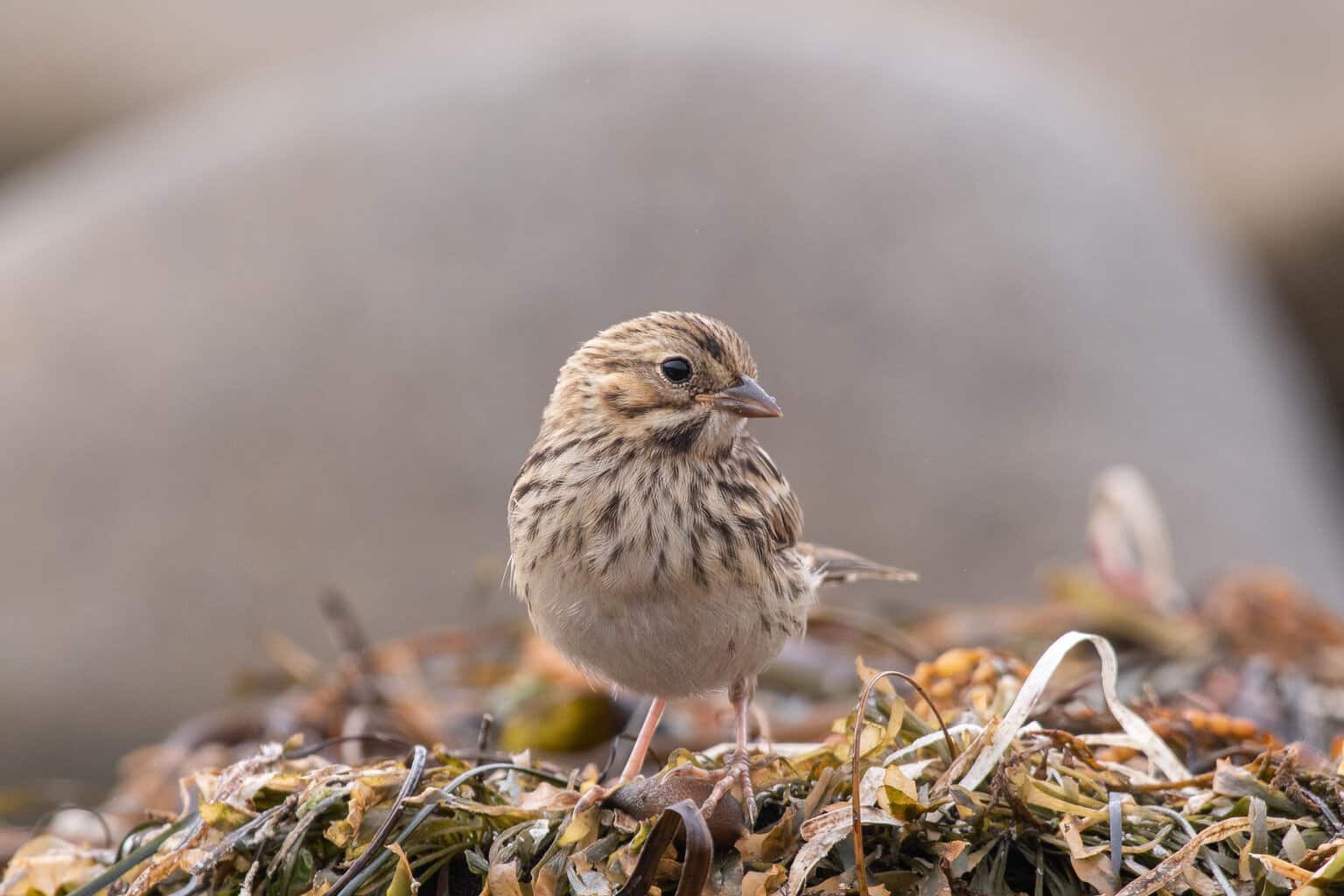
- Pooecetes gramineus
- ORDER: Passeriformes
- FAMILY: Passerellidae
- Length: 5.1-6.3 in (13-16 cm)
- Weight: 0.7-1.0 oz (20-28 g)
- Wingspan: 9.4 in (24 cm)
As one of the largest sparrows in North America, the Vesper Sparrow has distinctive white eyerings and brown patches on the shoulders. The rest of the Vesper Sparrow’s body is streaky and brown.
They get their name from the beautiful song that they sing at sundown – the same time that some Christian traditions hold a Vesper prayer service.
For the most part, Vesper Sparrows are found all summer in Ohio. Interestingly, though, they don’t breed in the Wayne National Forest area, in the state’s southeast corner. You may still see them in this region, traveling through during their migration periods.
Sparrows in Winter in Ohio
There are four kinds of sparrows that travel to Ohio specifically for the winter. These are the America Tree Sparrow, the Dark-Eyed Junco, the White-Crowned Sparrow, and the White-Throated Sparrow.
American Tree Sparrow
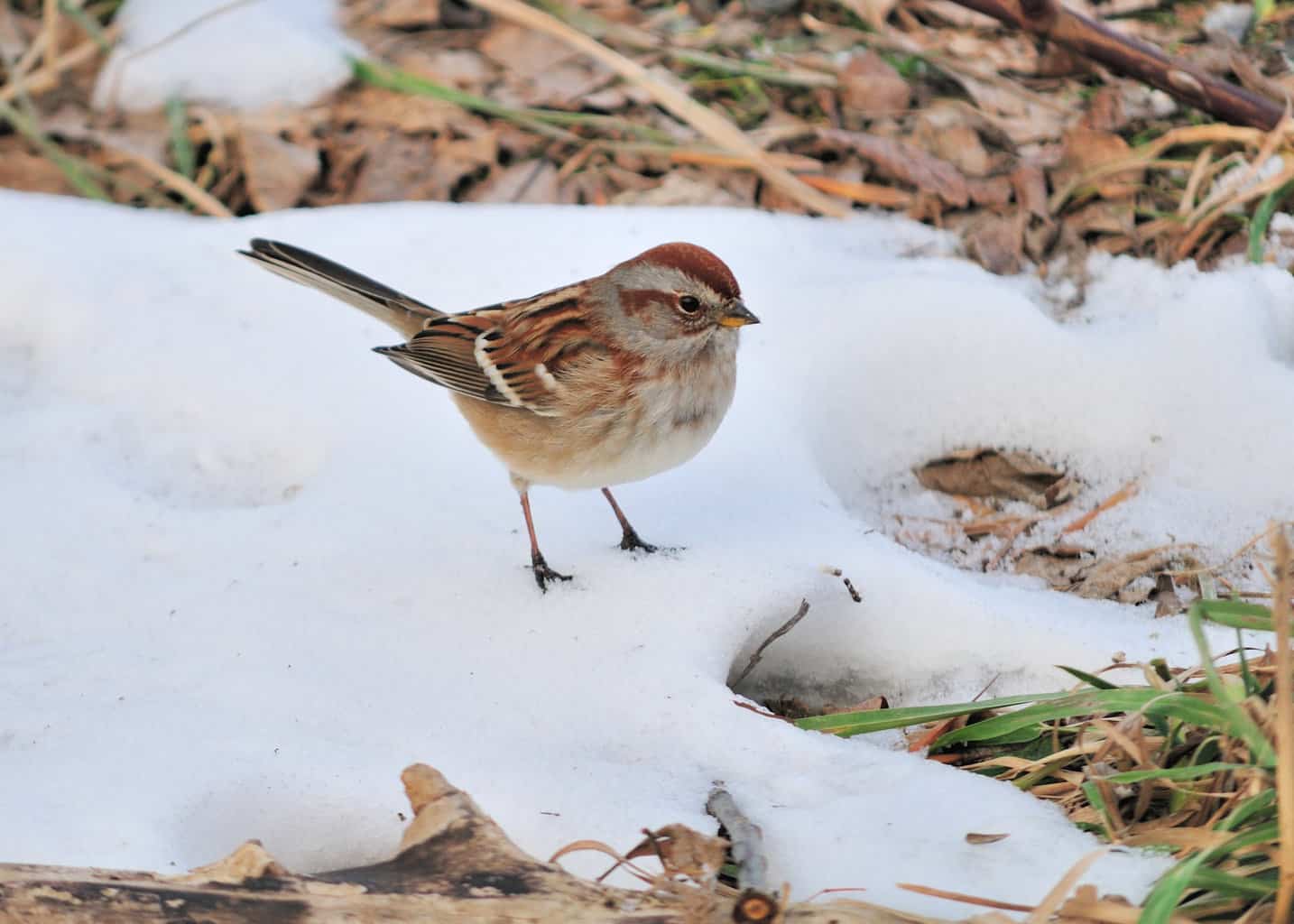
- Spizelloides arborea
- ORDER: Passeriformes
- FAMILY: Passerellidae
- Length: 5.5 in (14 cm)
- Weight: 0.5-1.0 oz (13-28 g)
- Wingspan: 9.4 in (24 cm)
Although the red patch on the breast of some American Tree Sparrows makes them easier to identify, other American Tree Sparrows lack this distinctive marking. All adults of this species have gray bodies, streaked wings, and a dark red crown.
They arrive in Ohio for the winter after spending their breeding season in Canada. Their winter territory stretches far across the US, as far south as North Texas! In Ohio, you will find them throughout the state during the winter.
They tend to stay in thick shrubs and bushes where there is plenty of shelter from predators. They can be spotted along snow-covered fields.
They eat a lot, consuming 30% of their body weight in food every single day. They mostly eat seeds in the winter, although they will also consume berries and the occasional insect.
Dark-Eyed Junco
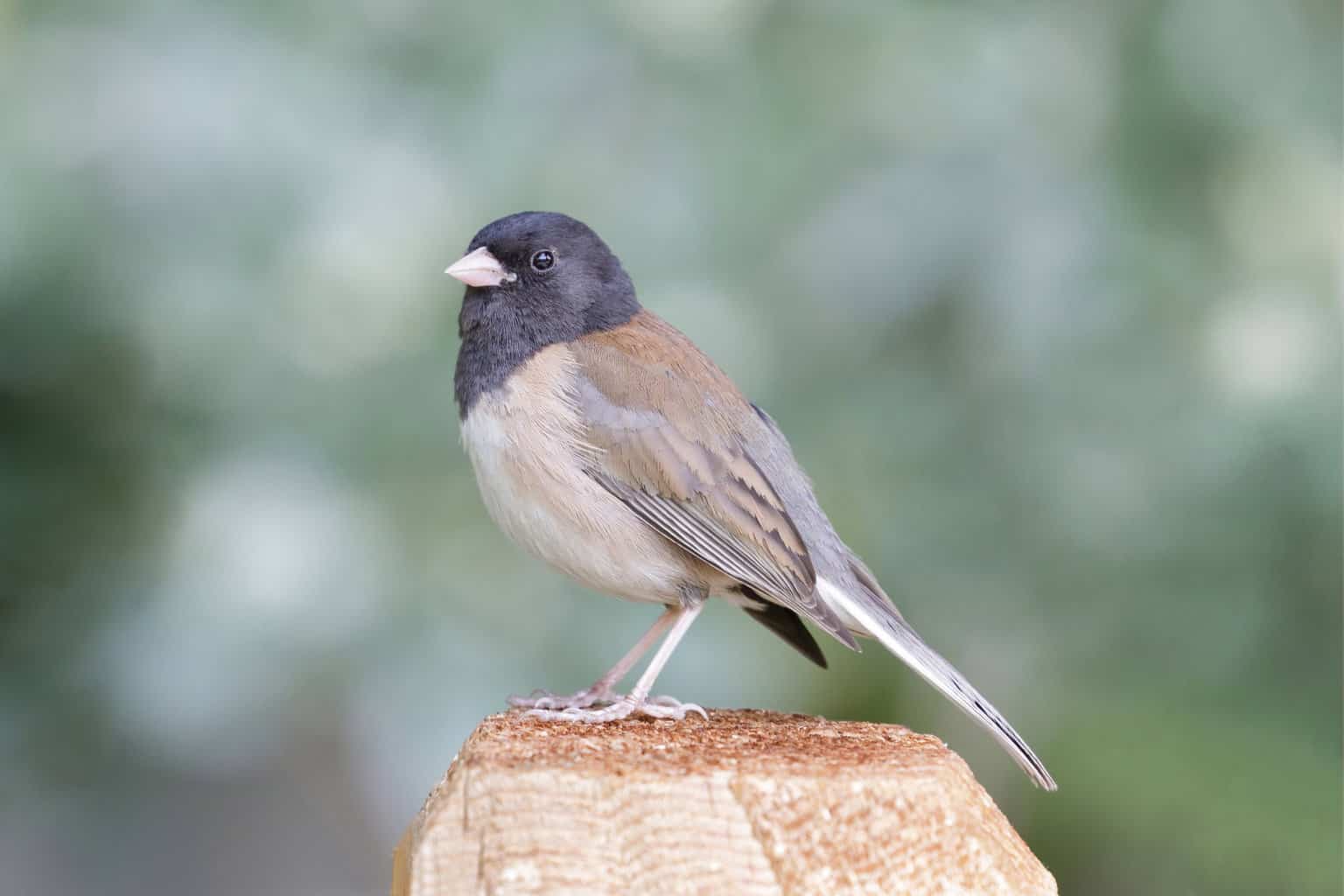
- Junco hyemalis
- ORDER: Passeriformes
- FAMILY: Passerellidae
- Length: 5.5-6.3 in (14-16 cm)
- Weight: 0.6-1.1 oz (18-30 g)
- Wingspan: 7.1-9.8 in (18-25 cm)
Dark-Eyed Juncos are sometimes called “snowbirds” because they are so often associated with the arrival of winter. When winter arrives in Ohio, you will likely see these cute little birds in small flocks (15-25 birds) visiting backyard feeders.
The Dark-Eyed Junco has a round body and a dark-gray appearance. They look almost black from a distance, but they have white chests and bellies. Females and males look similar to one another, both with a pink bill and white markings on their outer tail feathers.
They tend to choose mixed-coniferous forests, so watch for them in Ohio’s beautiful forested land.
White-Crowned Sparrow
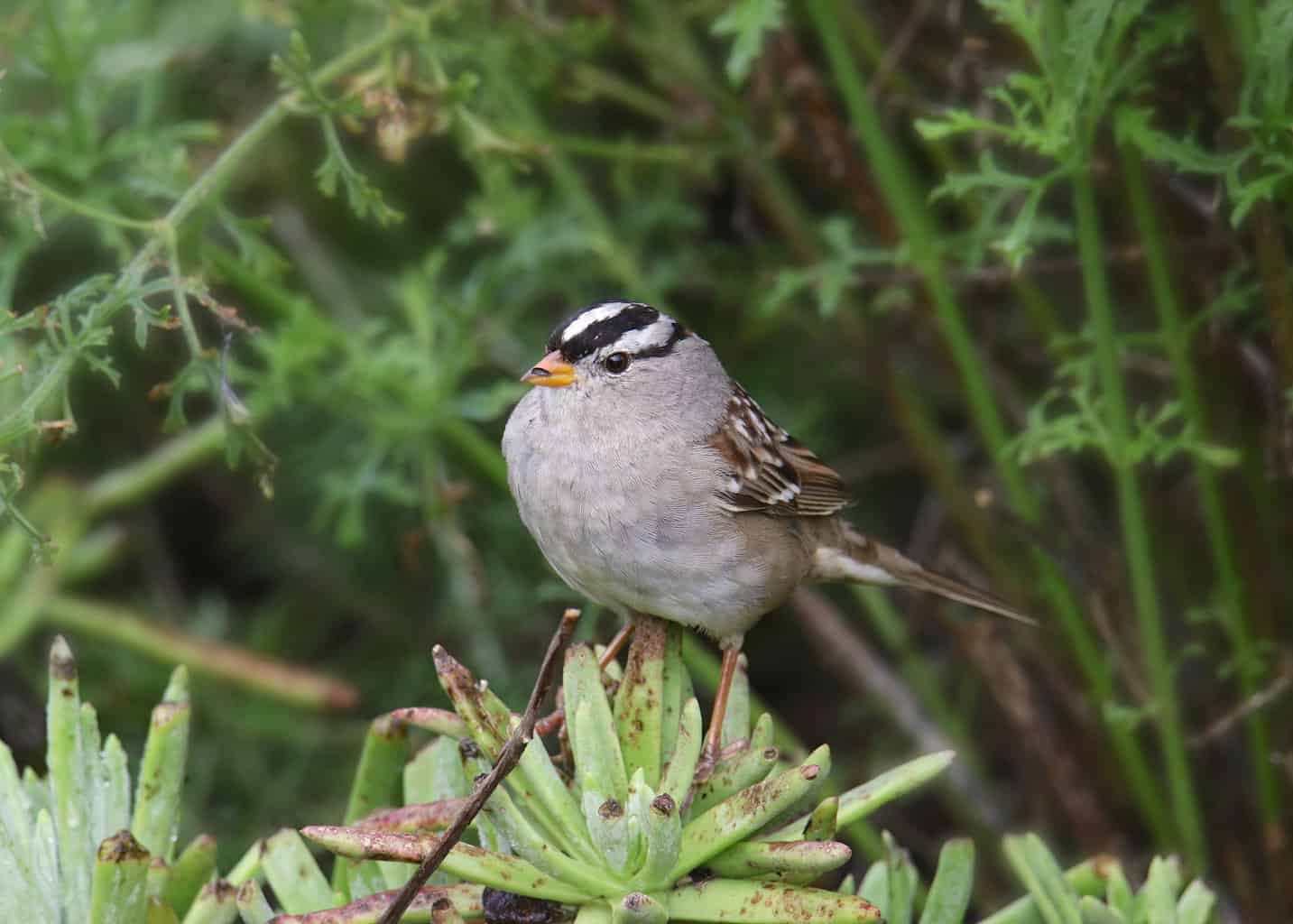
- Zonotrichia leucophrys
- ORDER: Passeriformes
- FAMILY: Passerellidae
- Length: 5.9-6.3 in (15-16 cm)
- Weight: 0.9-1.0 oz (25-28 g)
- Wingspan: 8.3-9.4 in (21-24 cm)
White-Crowned Sparrows are large with an extra-long tail. Their bill is small, and their head shape can change based on their circumstances. Sometimes, they will raise their feathers to create a peaked crest on their heads, whereas other times, their head looks flat and smooth.
White-Crowned Sparrows’ most distinctive characteristics are their black stripes, their yellow or pink bill, and the rounded shape of their body.
They can be found throughout Ohio in the winter, except in the far northeastern corner of the state. Northeast of Akron, they really only migrate through the area.
White-Throated Sparrow
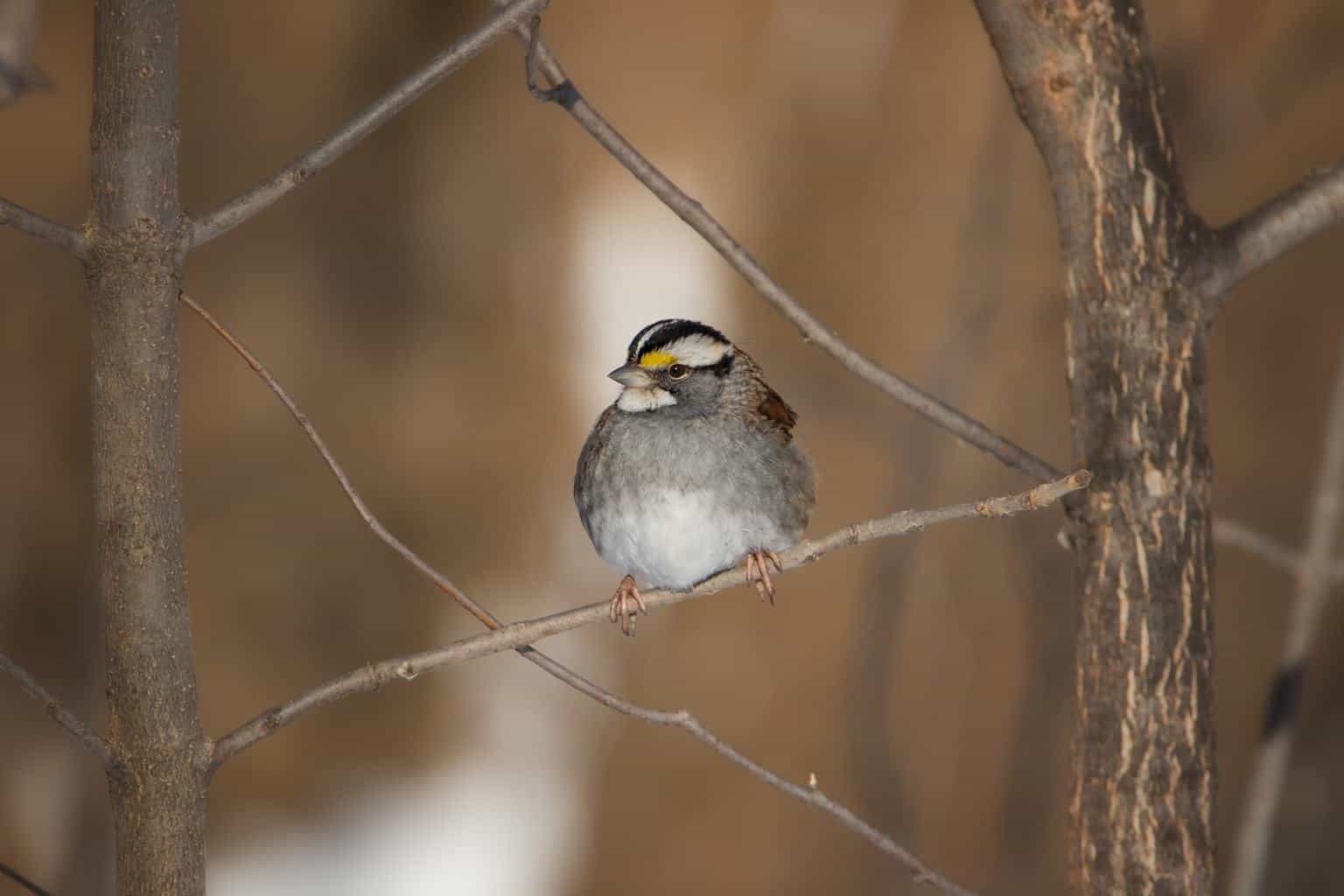
- Zonotrichia albicollis
- ORDER: Passeriformes
- FAMILY: Passerellidae
- Length: 6.3-7.1 in (16-18 cm)
- Weight: 0.8-1.1 oz (22-32 g)
- Wingspan: 7.9-9.1 in (20-23 cm)
White-Throated Sparrows come in two varieties: white-crowned and tan-crowned. There’s not a lot of difference in these variations, though. Otherwise, look for the yellow lores (the area between the bird’s eye and the bill) and black eyestripe.
White-Throated Sparrows sometimes mate with Dark-Eyed Juncos, creating a dull gray hybrid.
In the winter, White-Throated Sparrows gather together in large flocks, foraging for seeds from grasses and various weeds. They are found throughout Ohio. Look for them on the edges of fields, thickets, and hedgerows, as well as in suburban neighborhoods, city parks, and rural backyards.
Sparrows Who Migrate Through Ohio
Some sparrows are only present in Ohio when they are migrating between summer and winter territories. These migrating sparrows are the Clay-Colored Sparrow, the Fox Sparrow, the LeConte’s Sparrow, the Lincoln’s Sparrow, and the Nelson’s Sparrow.
Clay-Colored Sparrow
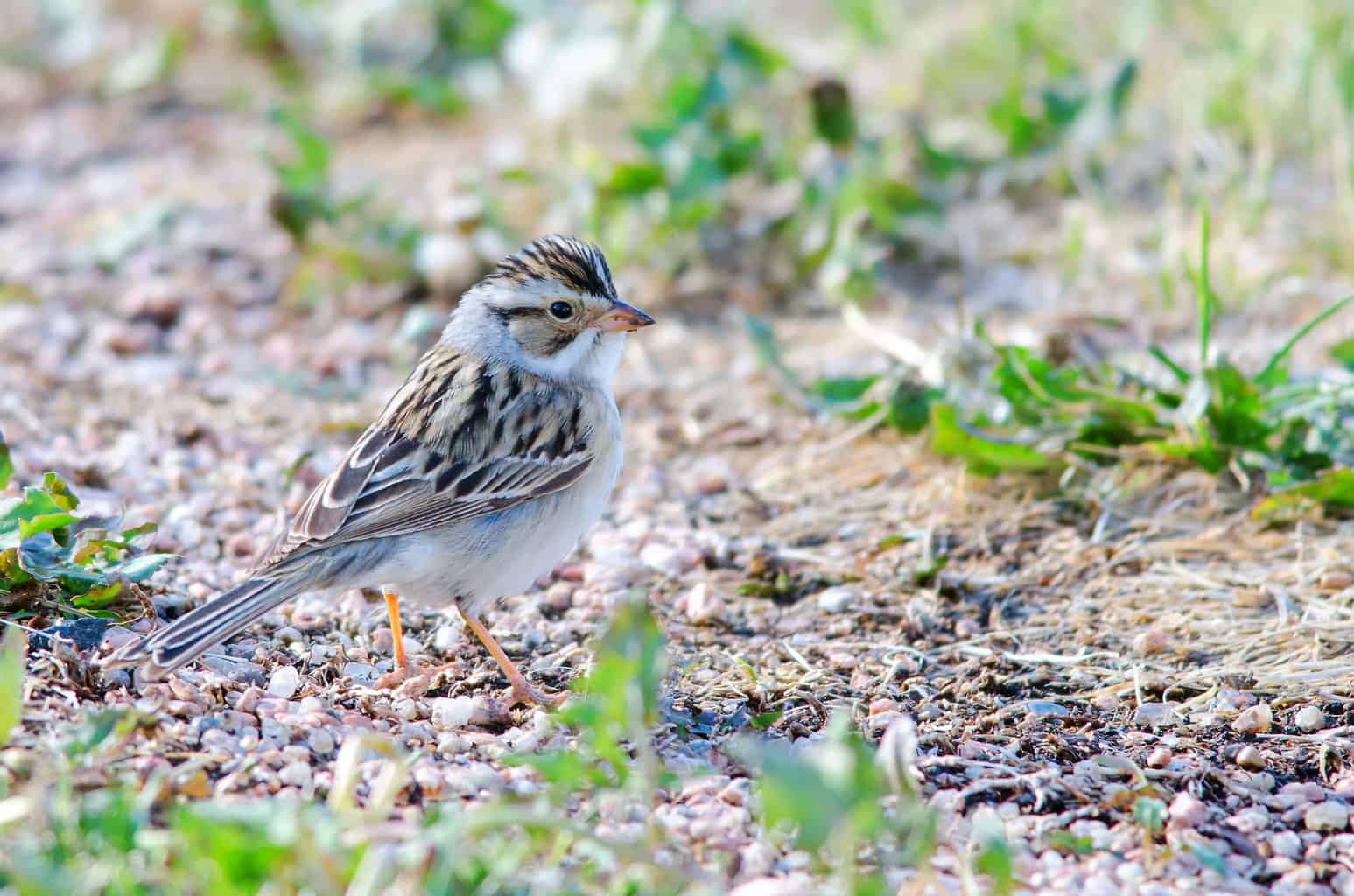
- Spizella pallida
- ORDER: Passeriformes
- FAMILY: Passerellidae
- Length: 5.1–6 in (130–150 mm)
- Weight: 12 g (0.42 oz)
- Wingspan: 7.5 in (190 mm)
Clay-colored Sparrows are a grayish-tan clay color, as their name implies. They have a pale collar around their neck and some thin, fine streaks on their head.
Their summer breeding range is limited to central Canada and the US/Canada border, and they spend the winter in Mexico. You can see them in Ohio as they migrate between these two areas.
Clay-colored Sparrows are usually found in thickets or right along the edges of fields. Even though they are declining in numbers, they are still commonplace and are a species of Least Concern.
Fox Sparrow

- Passerella iliaca
- ORDER: Passeriformes
- FAMILY: Passerellidae
- Length: 5.9-7.5 in (15-19 cm)
- Weight: 0.9-1.6 oz (26-44 g)
- Wingspan: 10.5-11.4 in (26.7-29 cm)
Because Fox Sparrows can have a lot of regional variation in their appearance, it is sometimes a challenge to identify them. They are small, gray sparrows with reddish-brown streaking. The amount of streaking varies significantly from one variation to the next.
Sometimes, the streaking is so dark and thick that they look almost entirely red! At other times, Fox Sparrows have only a few dark red streaks on their backs and wings.
Look for the dark brown chest spots that all Fox Sparrows have.
These messy little birds kick around in the leaf litter as they forage for seeds and insects. They migrate through northern and central Ohio, and some will also stick around in southern Ohio for the winter. You’re most likely to have a Fox Sparrow at your feeder in the spring or fall.
LeConte’s Sparrow
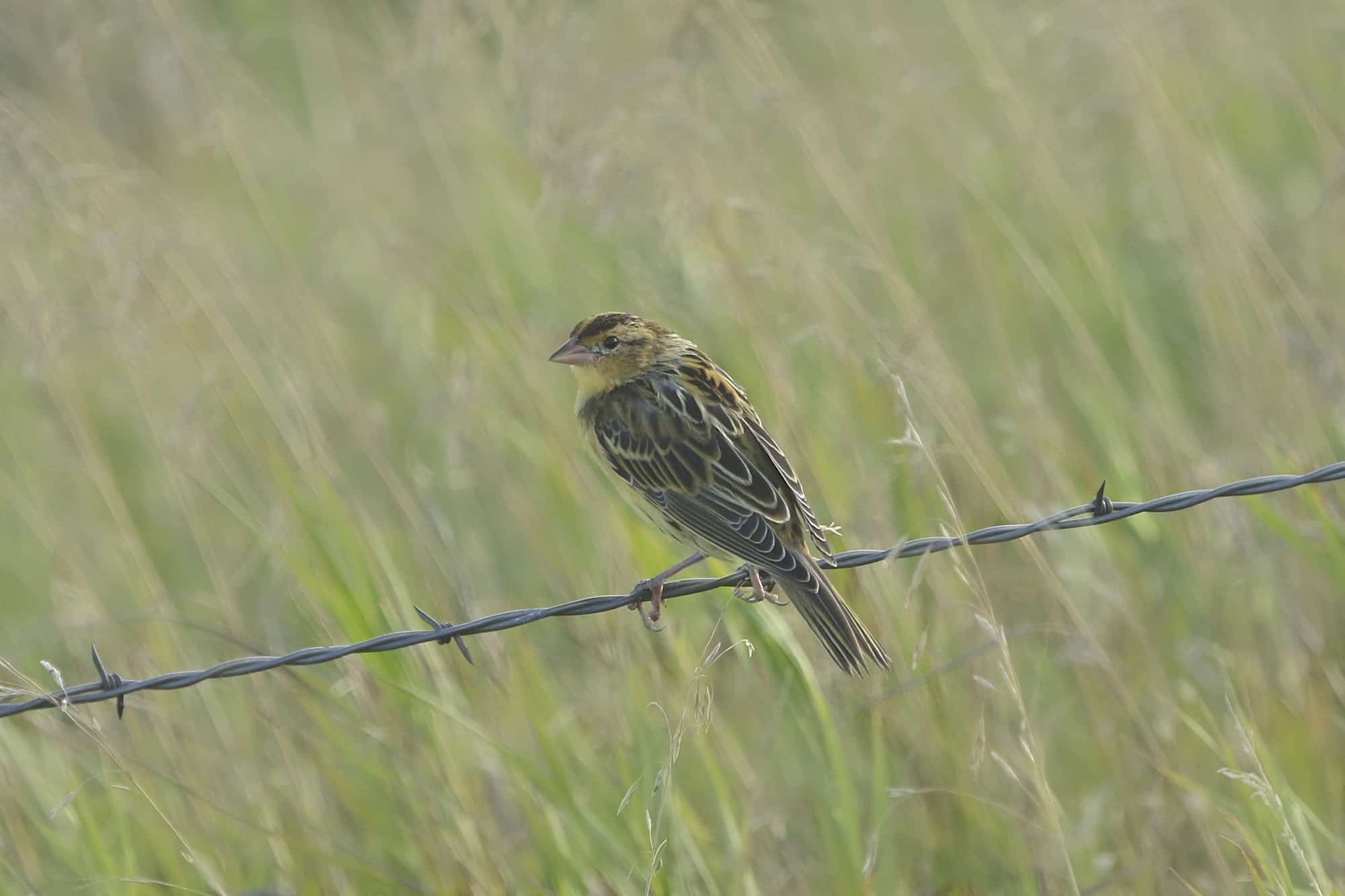
- Ammospiza leconteii
- ORDER: Passeriformes
- FAMILY: Passerellidae
- Length: 4.7-5.1 in (12-13 cm)
- Weight: 0.4-0.6 oz (12-16.3 g)
- Wingspan: 6.3-7.1 in (16-18 cm)
The reclusive LeConte’s Sparrow is great at camouflage. They have a reputation built on hiding from humans, year-round. They breed in highly remote areas and winter in the cover of thick brush.
They are pale orange in color with short wings that are streaked with black. There is also a grayish-purple patch on the back of their neck that you can see if you are behind them. Don’t expect to sneak up on a LeConte’s Sparrow, though.
Sometimes, they are described as mouse-like, as they scurry away from threats instead of flying. They can fly, of course, and they do so every year as they migrate. But for the most part, LeConte’s Sparrows spend a lot of time on the ground.
Their declining numbers are a concern for naturalists, which is why they have been placed on the Yellow Watch List.
They are very rare migratory visitors to Ohio. You are more likely to see them during migration if you live in Indiana or Illinois.
Lincoln’s Sparrow
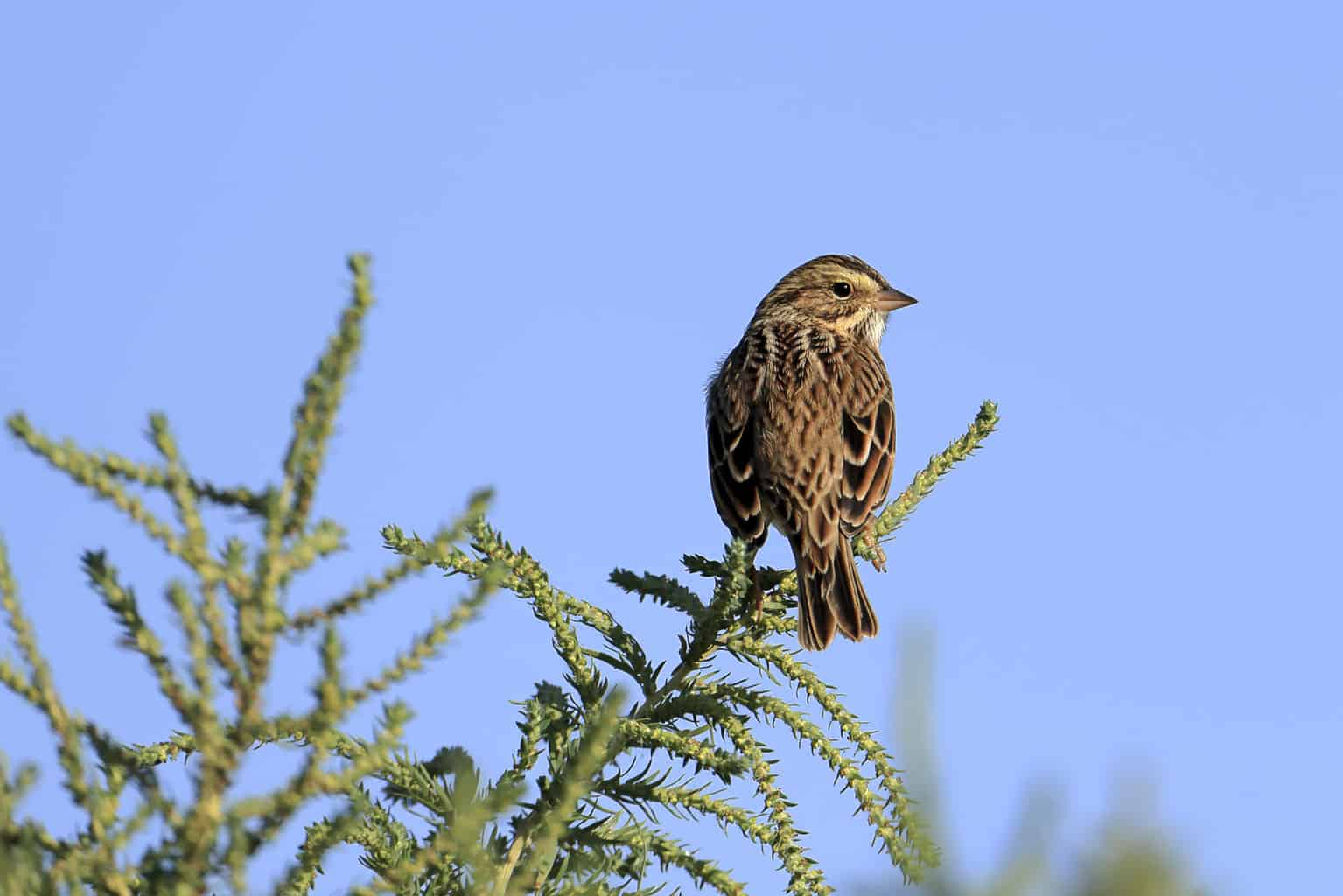
- Melospiza lincolnii
- ORDER: Passeriformes
- FAMILY: Passerellidae
- Length: 5.1-5.9 in (13-15 cm)
- Weight: 0.6-0.7 oz (17-19 g)
- Wingspan: 7.5-8.7 in (19-22 cm)
Identify Lincoln’s Sparrows by looking for the gray stripe that runs down the middle of the crown. You can also look at the pale mustache, the white belly, the rusty-brown tail and wing tips, and the dark brown stripes on the rest of the body.
Lincoln’s Sparrows are another sparrow who are skilled at avoiding detection! They rarely leave the cover of the willow thickets where they live, except to sing a pretty spring song that sounds similar to that of a House Wren.
Their spring migration occurs between March and May, and their fall migration starts in October. Those are the only times you are likely to see them as they migrate through Ohio.
During their migration, they spend a lot of time hiding in thickets along the roadside or forest.
Nelson’s Sparrow
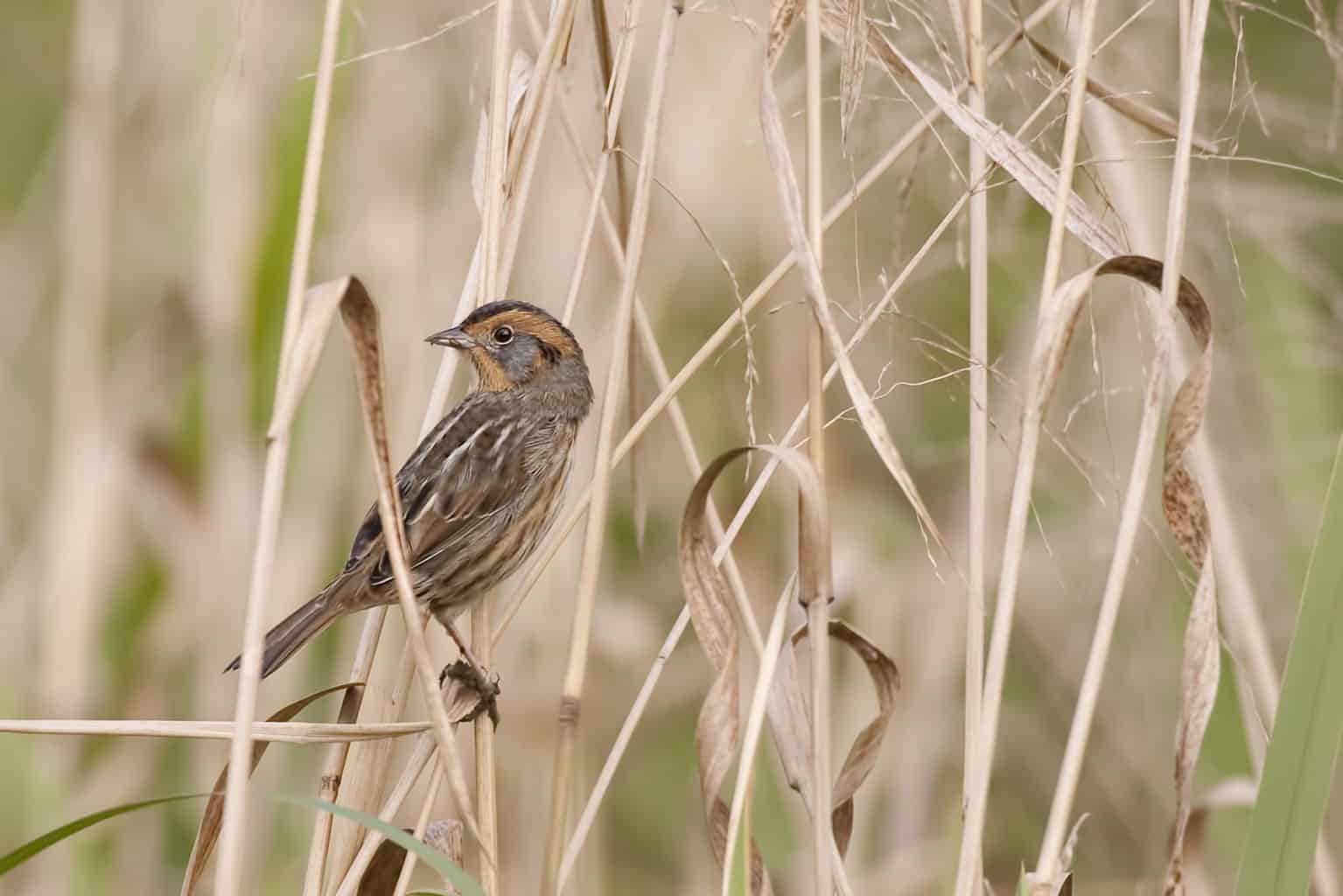
- Ammospiza nelsoni
- ORDER: Passeriformes
- FAMILY: Passerellidae
- Length: 4.3-5.1 in (11-13 cm)
- Weight: 0.6-0.7 oz (17-21 g)
- Wingspan: 6.5-7.9 in (16.5-20 cm)
The yellow and brown Nelson’s Sparrow has dark yellow coloring on its face. They also have gray cheeks and thin streaking on their chest, which is banded in yellow. They are typically found on the ground, hiding among the dense vegetation that grows in marshy areas.
They tend to stop during their migration along the Great Lakes, so Ohio residents or visitors near Lake Erie have the best chance of seeing them in the spring or fall.
Nelson’s Sparrows were only differentiated from Saltmarsh Sparrows in 2009. These two species were previously called the Sharp-Tailed Sparrow. The Nelson’s Sparrow is named for the American naturalist Edward William Nelson.
Enjoy Looking for Sparrows in Ohio
Now that we’ve introduced you to the 20 different kinds of sparrows that you can find in Ohio, it’s time to go look for them!
The best way to start identifying sparrows is to become more attentive to your surroundings. Sometimes, these little birds are so commonplace that they can be easy to overlook. However, once you start paying attention to the differences between them, you will start to notice just how many types of sparrows you encounter every year.

